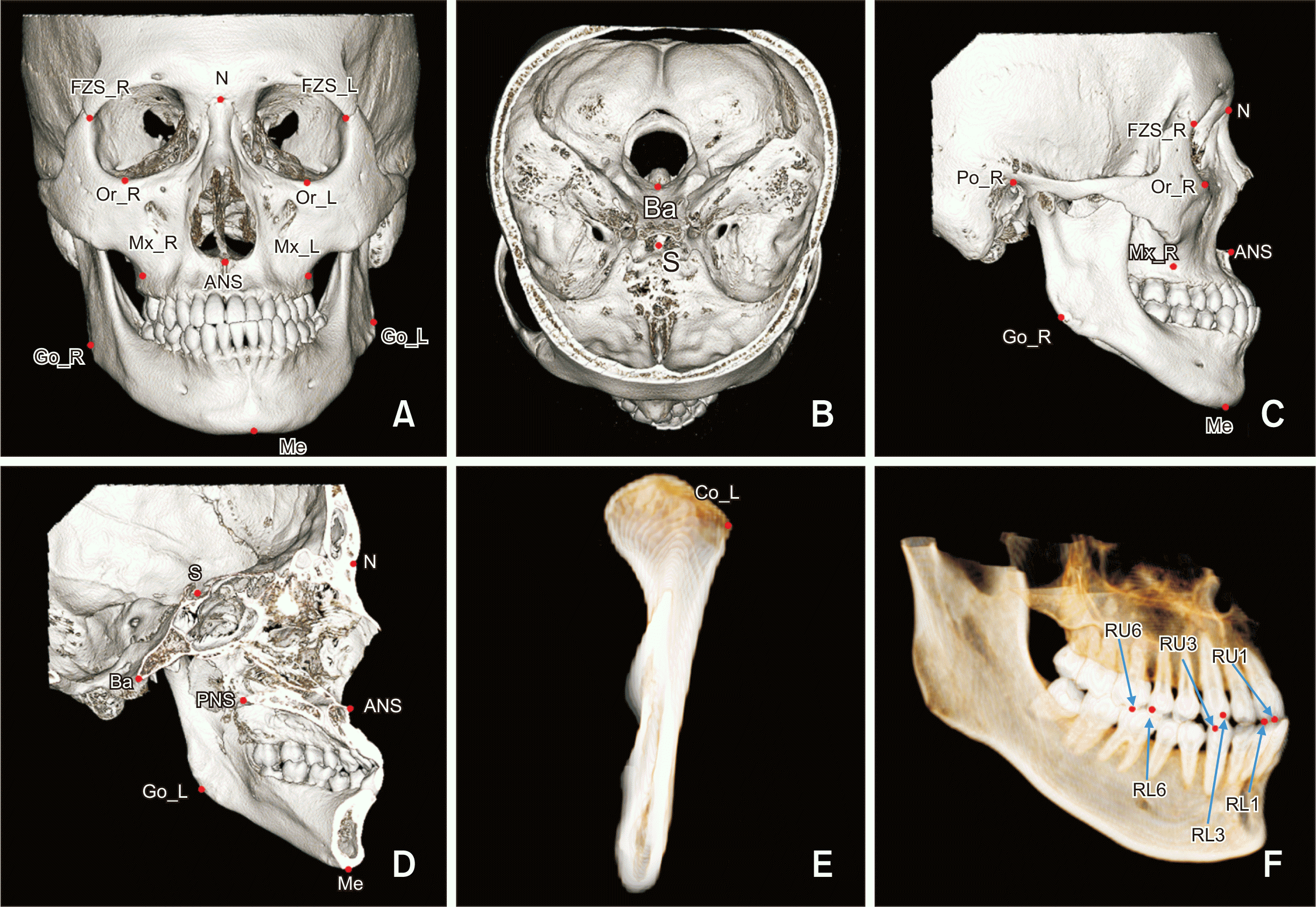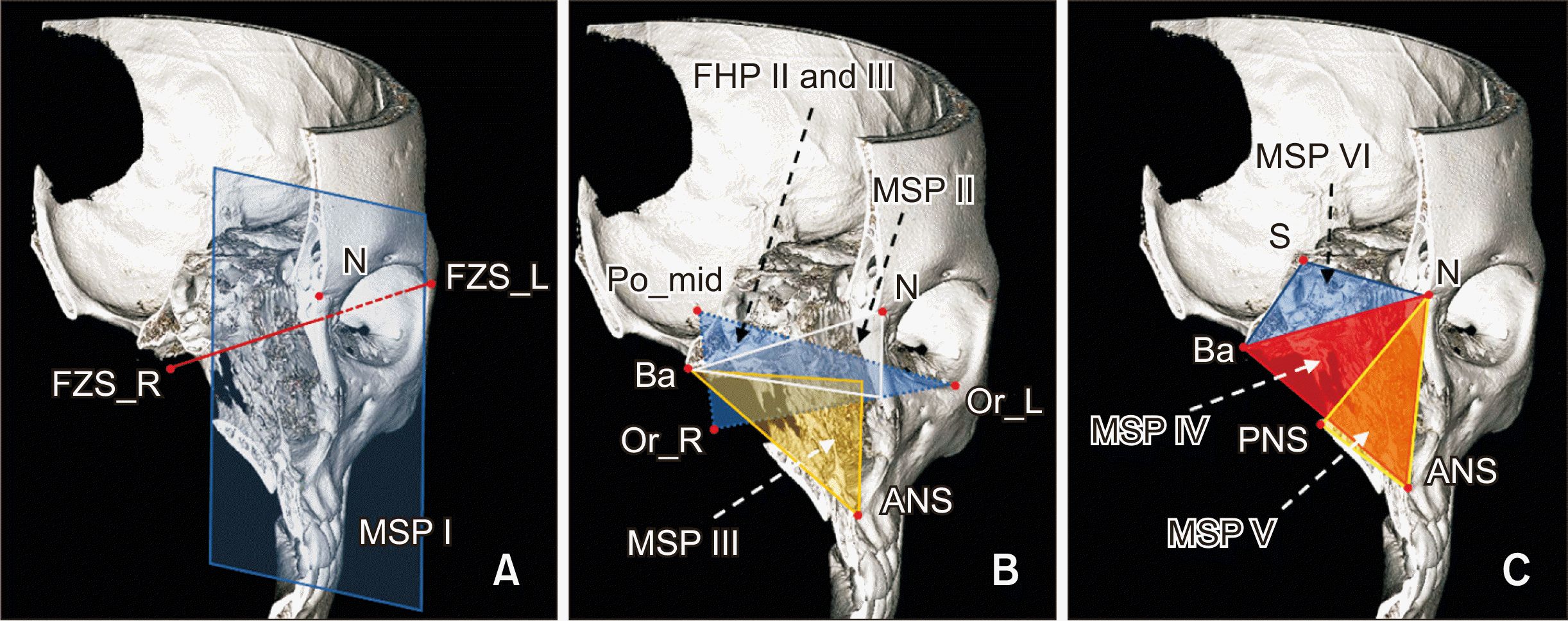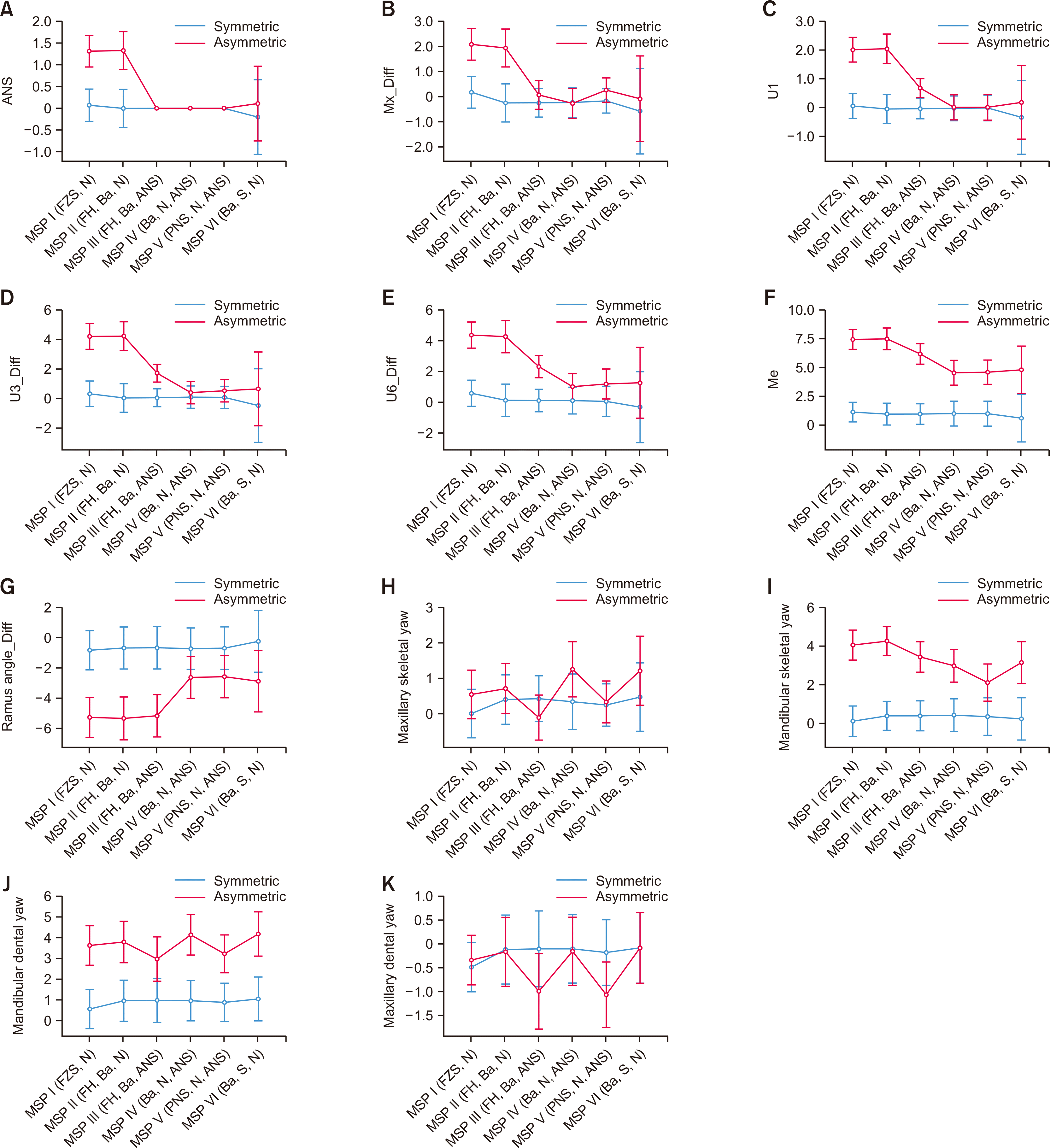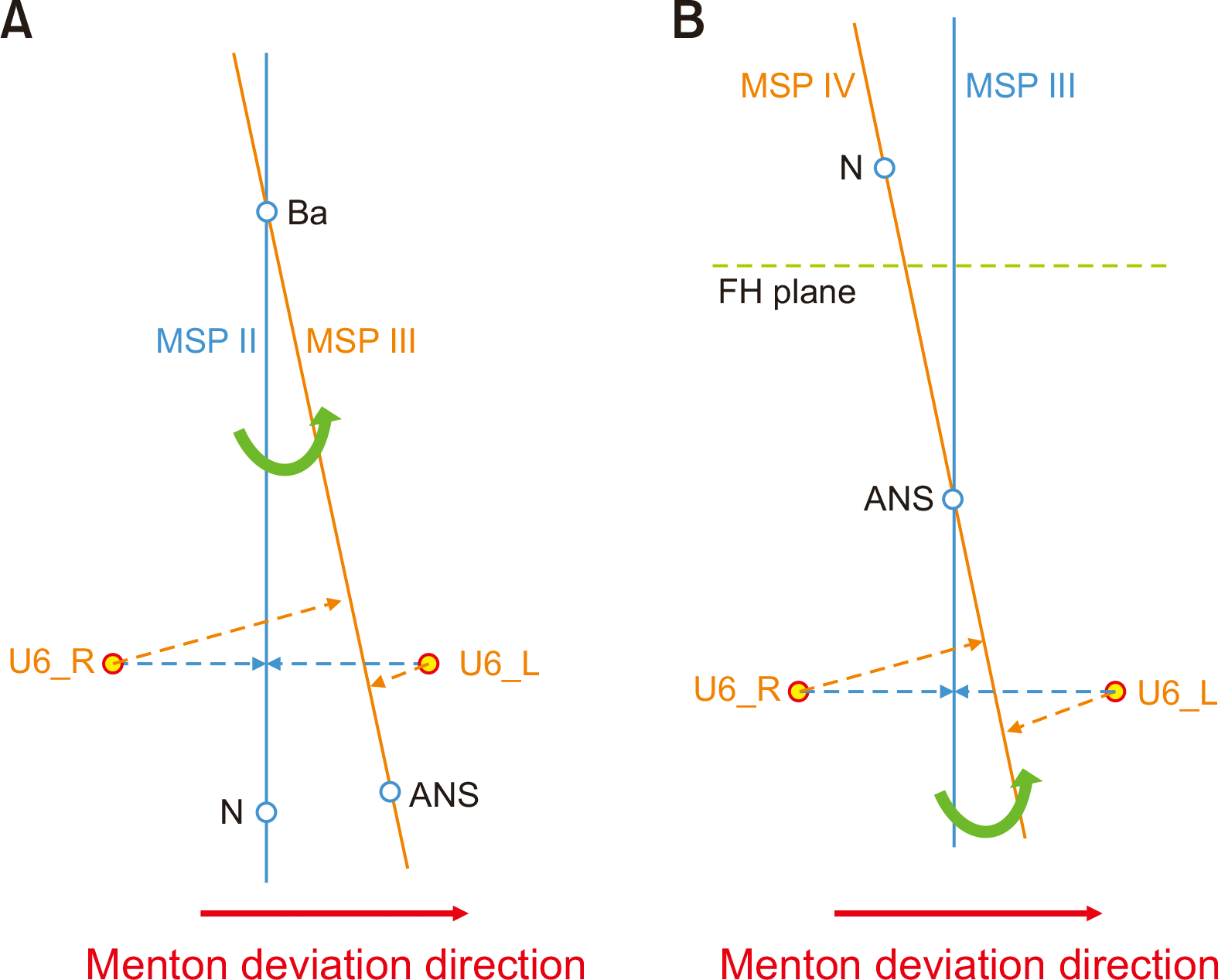INTRODUCTION
The midsagittal plane (MSP) demarcates the two sides (left and right) of the body. Various attempts have been made to construct an accurate MSP. Mathematically, morphometric or least-square approximated MSPs are usually considered as true MSPs.
1-4 However, the general use of these methods remains debatable.
3-5 Conventional cephalometric MSP remains the most preferred method for defining an MSP.
A cephalometric MSP is defined based on geometric rules and anatomic landmarks. The main research goal regarding cephalometric MSPs is to determine the optimal combination of landmarks and construction schemes.
2-12 Studies in the relevant literature have recommended several cephalometric MSPs. However, currently, there is no consensus on a cephalometric definition of MSP. To date, choosing landmarks from the mid-facial area, such as the anterior nasal spine (ANS) is debated.
4-7,9,11,13
The aforementioned arguments exist due to the possibility of positional bias in midfacial landmarks for patients with facial asymmetry.
6,7,13 It has been suggested that the results of asymmetry evaluation may vary if midfacial landmarks are included in the definition of MSP.
7,9 Furthermore, given that the asymmetry confirmed during diagnosis is directly reflected in the treatment plan, this diagnostic difference is clinically relevant. However, only a few studies have quantitatively examined the differences among various MSPs, despite their clinical importance.
This study aimed to clarify the diagnostic differences caused by interactions between cephalometric MSPs and facial asymmetry. Commonly used three-dimensional (3D) measurements were statistically compared for different MSPs. We then examined how asymmetry assessments differed with MSPs in patients with skeletal Class III facial asymmetry. Our null hypothesis stated that no statistical interaction would exist between MSPs and facial asymmetry.
MATERIALS AND METHODS
Research data were collected from the diagnostic records of patients who visited the Department of Orthodontics at Kyungpook National University Dental Hospital for surgical orthodontic treatment between 2012 and 2019. The inclusion criteria were as follows: ANB angle ≤ 0°, no malformed teeth, no prosthetic crowns, no missing or supernumerary teeth, symmetrically distributed crowding or spacing < 3 mm, no craniofacial syndrome, and no previous orthodontic treatment. The menton deviation was measured from the initial posteroanterior cephalograms to classify the study participants. Moreover, the symmetry and asymmetry groups comprised of patients with menton deviations of < 2 mm and > 4 mm, respectively. Patients with menton deviations of 2–4 mm were excluded, and data from 60 patients (30 per group) were analyzed. The participant characteristics are summarized in
Table 1. This study was approved by the Institutional Review Board of the Kyungpook National University Dental Hospital (KNUDH-2022-03-02-00).
Pre-treatment cone-beam computed tomography (CBCT) was performed with the patient in the maximum intercuspal position for diagnostic purposes. The settings of the CBCT scanner (CB MercuRay; Hitachi, Osaka, Japan) were as follows: 15 mA, 120 kV, exposure time of 9.6 s, voxel size of 0.2 mm, axial slice thickness of 0.38 mm, and field of view of 19.3 × 19.3 cm. All the captured images were stored in digital imaging and communication in medicine (DICOM) format, and they were three-dimensionally reconstructed using volume-rendering software (InVivo Dental, version 5.4; Anatomage, San Jose, CA, USA).
Definitions of the skeletal and dental landmarks used in this study are presented in
Table 2 and
Figure 1. After selecting the approximate position of a landmark on the volume-rendered image, the final location was finely adjusted in a multiplanar view that showed the axial, frontal, and sagittal cuts simultaneously.
Six MSPs were compared (
Table 3,
Figure 2). These MSPs were used according to the recommendations of previous studies (MSPs I, II, IV, V, and VI) or with minor modifications (MSP III) from previous studies.
3,4,8,9,12 Furthermore, MSPs I (FZS, N), II (FH, Ba-N), and VI (Ba-S-N) were defined using the cranium and upper facial landmarks alone, whereas the definitions of MSPs III (FH, Ba-ANS), IV (Ba-N-ANS) and V (PNS-N-ANS) included mid-facial landmarks.
Subsequently, 3D analyses were performed. Maxillomandibular skeletal and dental asymmetries were calculated for each MSP. Linear measurements included the distance of the landmarks from the MSPs, whereas angular measurements included the ramus angle and maxillary and mandibular skeletal/dental yaws. Notably, positive signs were assigned when the skeletal and dental yaws as well as the transverse position of the midline landmarks, such as the ANS and upper incisor, were in the direction of menton deviations. The detailed definitions of these measurements are presented in
Table 4 and
Figure 3.
Statistical analysis
The sample size was estimated using G*Power software (version 3.1.9.7; Franz Faul, Christan-Albrechts-University, Kiel, Germany). The numbers of groups (between-subject factor; symmetric/asymmetric) and repeat measurements (within-subject factor; MSPs) were two and six, respectively. With an effect size of 0.65, a significance level of 0.05, and a test power of 0.85, the minimum number of patients required in each group was estimated to be 20. Furthermore, based on the central limit theorem, the number of patients in each group was determined to be 30.
Furthermore, to verify the reliability of the measurements, 30 patients were randomly selected, and landmarking was repeated for these patients at intervals of 4 weeks. We used a two-way mixed, single-rater, and absolute agreement model to calculate the intraclass correlation coefficient (ICC) for the coordinates of each landmark. Moreover, Dahlberg’s formula () was used to estimate the method errors for these coordinates.
We used the Shapiro–Wilk test to examine the normality of the measured variables. After assessing the equality of variances using Levene’s test, an independent
t-test was used to confirm the matching of sample characteristics between the two groups. The sphericity assumption among the variables of repeated measurements was significantly violated according to the results of Mauchly’s test (
p < 0.001). Therefore, the statistical interaction between MSPs and facial asymmetry was evaluated using multivariate analysis of variance (MANOVA), which is more robust than a mixed analysis of variance approach whereby the sphericity assumption is not applicable.
14 To further interpret this interaction, simple main-effect analyses and subsequent pairwise comparisons with Bonferroni correction were performed.
All statistical analyses were performed at a significance level of 5% using the SPSS software version 26 (IBM Corp., Armonk, NY, USA).
RESULTS
The coordinates of all the landmarks demonstrated high reproducibility for repeated measurements, with a mean ICC of 0.994 (range: 0.922–1.000). Notably, the estimated method errors were 0.35 mm, 0.43 mm, and 0.51 mm for x, y, and z coordinates, respectively. Therefore, we used the first set of measurement data for the subsequent analyses.
The patient factors that might have affected the study results are presented in
Table 1. Age, anteroposterior skeletal patterns, and vertical skeletal patterns did not differ significantly between the symmetric and asymmetric groups. Only menton deviation, which was the group-dividing factor, demonstrated high significance (
p < 0.001).
Table 5 presents descriptive statistics for each variable. The mean and standard deviation values of the variables measured at each level using a combination of within-subject (MSPs) and between-subject (symmetry and asymmetry) factors are presented in
Table 5. In the symmetric group, all the measurements demonstrated similar values among the MSPs. However, in the asymmetric group, the outcomes differed among the MSPs. Notably, skeletal/dental measurements determined according to MSP VI (Ba-N-ANS) demonstrated a remarkably larger standard deviation than those determined according to other MSPs, irrespective of the patient group.
Furthermore, MANOVA revealed a highly significant interaction between MSP and facial symmetry for all the variables (
p < 0.01;
Supplementary Table 1). Subsequent simple main-effect analysis, which is another MANOVA used to investigate the effect of MSPs in each group (symmetric and asymmetric), confirmed that no significant difference was observed according to MSPs in the symmetric group (
p-values ranging from 0.215–0.933,
Supplementary Table 2). However, all the measurements in the asymmetric group were highly significant among the MSPs (
p < 0.001).
The profile plots (
Figure 4) graphically summarize the results of pairwise comparisons in the asymmetric group. Only representative variables are presented for simplicity. The pairwise comparison results are presented in the Supplementary Data (
Supplementary Table 3). No statistically significant differences were observed in the linear measurements and ramus angle between MSPs I (FZS, N) and II (FH, Ba-N) and between MSPs IV (Ba-N-ANS) and V (PNS-N-ANS). However, significance was evident (
p < 0.001) in comparisons between MSPs II (FH, Ba-N) and III (FH, Ba-ANS) and between MSPs III (FH, Ba-ANS) and IV (Ba-N-ANS). Moreover, skeletal and dental yaws showed fluctuation patterns within a range of 1° among the MSPs.
The differences in the asymmetry measurements between the MSPs are presented in
Table 6. The matching MSP pairs were combined by averaging. Specifically, MSPs I (FZS, N) and II (FH, Ba-N) were merged into the upper facial MSP, whereas MSPs IV (Ba-N-ANS) and V (PNS-N-ANS) were merged into ANS-associated MSP. Statistical significance was confirmed for all the measurements using the paired
t-test (
p < 0.001). ANS-associated MSP could not identify the maxillary skeletal and dental transverse asymmetries. Furthermore, the menton deviations were evaluated differently as 7.5 mm and 4.6 mm using upper facial and ANS-associated MSPs, respectively. Similarly, the ramus angle difference tended to be underestimated by ANS-associated MSPs than that by upper facial MSPs by a factor of 2.69°.
DISCUSSION
Previously, An et al.
9 studied how ANS deviation, menton deviation, and maxillary yaw were evaluated in eight cephalometric MSPs using CBCT data from 30 patients with facial asymmetry. Although the midline landmark MSP tended to evaluate asymmetry less, no clinically significant difference was observed between the MSP perpendicular to the Frankfort horizontal (FH) plane and the midline landmark MSP. Similarly, Damstra et al.
2 measured skeletal/dental asymmetry using six cephalometric MSPs with 14 dry skulls (five in the asymmetric and nine in the symmetric group). The MSPs perpendicular to the FH plane showed significantly greater asymmetry than the midline landmark MSPs. Both studies confirmed that the midline landmark MSP evaluated asymmetry smaller, whereas the size of the difference in the actual measured values differed between the studies. These differences may be attributed to the characteristics of the samples used in each study. An et al.
9 did not present detailed data on the characteristics of 30 patients with asymmetry; however, the sample size in the study by Damstra et al.
2 was too small to generalize their findings. Therefore, in this study, we investigated the interaction between facial asymmetry and the MSP type using 30 patients per group and explicitly presented the patient characteristics.
Statistically significant interactions were confirmed between MSPs and facial symmetricity. The between-group (symmetric and asymmetric) differences in each variable were significantly different in at least one of the six MSPs (
Figure 4). However, the significant interaction originated from the asymmetric group rather than the symmetric group because the measurement outcomes varied significantly among MSPs in the simple main-effect analyses of the asymmetric group. Therefore, the null hypothesis was rejected.
MSP VI (Ba-S-N) was incorporated to determine the effect of the MSP, which was defined by the three midline landmarks in the cranium and upper facial areas. However, the large standard deviations, which were 2–4 times larger than those of the other MSPs, were confirmed by the measurement results presented in
Table 5 for both the symmetric and asymmetric groups. Geometrically, when the landmarks that define the MSP are close, even a small change in the landmark position can remarkably change the overall orientation of the MSP.
2,4,15 Therefore, slight cranial base asymmetries may lead to MSP deflection and consequent misinterpretation of facial asymmetry.
16 Thus, MSP VI (Ba-S-N) was considered an inappropriate reference plane and was excluded from subsequent analyses.
The profile plots (
Figure 4) show the fluctuating patterns in the yaw measurements from MSPs II (FH, Ba-N) to V (PNS-N-ANS). Changes in the alignment of the MSP may have been entangled three-dimensionally with the angular measurement methods via projection onto the horizontal plane (
Table 4), which may have led to variations among the MSPs. However, the overall magnitude of variation was < 1°, rendering it clinically insignificant. Therefore, we determined that the differences in skeletal and dental yaw measurements were negligible among the MSPs.
The plateaus observed in the profile plot (
Figure 4) indicate that MSPs I (FZS, N) and II (FH, Ba-N) were mutually equivalent pairs for the ramus angle and linear asymmetry measurements. Similarly, MSPs IV (Ba-N-ANS) and MSP V (PNS-N-ANS) are interchangeable. However, substituting MSP I (FZS, N) or II (FH, Ba-N) with MSP IV (Ba-N-ANS) or V (PNS-N-ANS) may not be possible because of the evident tendency for reduction over a clinically significant range between them.
17-19 MSP III (FH, Ba-ANS) was experimentally introduced in this study to facilitate the understanding of this outcome. Notably, previous studies have reported that the ANS can deviate in the direction of mandibular asymmetry.
6,7,13 Consequently, as illustrated in
Figure 5, MSP tilting in the horizontal and frontal planes in the chin deviation direction can be induced, which would further reduce the corresponding ramus angle and transverse linear measurements.
The diagnostic differences according to different MSPs are summarized in
Table 6. The identified diagnostic discrepancies between upper facial- and ANS-associated MSPs may lead to the development of different surgical plans. For example, the required mandibular movement based on the menton deviation differs between these MSPs, i.e., the 3 mm difference in chin deviation is in a clinically non-negligible range according to perception studies.
17,19 Moreover, transverse maxillary correction may not be indicated by ANS-associated MSP, whereas upper facial MSP may indicate a translational movement of the maxilla to the non-deviated side when two-jaw surgery is considered.
20 The overall aesthetics of the face after treatment may vary depending on the MSP because the maxilla determines the final position of the mandible.
21,22
Presurgical orthodontic treatment plans may also be affected by the MSP type. Dental compensation in asymmetric patients is a well-known phenomenon reported in the literature. Many CBCT studies have confirmed flaring of the molars and canines and deviation of incisors in the asymmetric direction, along with a resultant transverse discrepancy between the deviated and non-deviated sides.
23-26 However, in this study, this characteristic compensational pattern in the transverse distance could be reproduced only in the upper facial MSP. ANS-associated MSP cannot detect a transverse dental discrepancy between the sides, which suggests that presurgical orthodontic treatment goals may differ according to the type of MSP.
Recently, ANS-associated MSPs have been gathering attention.
3-5,10 Interestingly, to our knowledge, the above-mentioned dental compensation has been verified mainly using upper facial MSPs. In contrast, CBCT dental compensation studies using ANS-associated MSP are rare. As the current results imply, the dental compensation pattern might be observed differently depending on the MSPs. Future studies on the differences in dental compensation according to various reference planes are required.
Unfortunately, no consensus exists on MSP selection. Finding an objective and scientific basis to support the idea that one MSP is more appropriate than another is challenging. Although various MSPs have been proposed based on mathematical and geometric techniques, they could be optimal only in their domains (upper face or upper to middle face).
2-4 As a result, an MSP that is optimal in one domain may not be optimal in another, resulting in a significant difference in the diagnostic outcome, as demonstrated in this study.
The lack of an absolute reference MSP may make it difficult to reach an agreement. Given that the ultimate treatment goals are soft tissue symmetry and beauty, 3D facial scanning technology may offer a way to resolve this controversy. For example, taking 3D facial images with the patient in a natural head position and merging them with CBCT data may help define the most reliable MSP. Therefore, further studies are warranted in this regard.
This study divided the samples into symmetric and asymmetric groups based on menton deviation. The standard deviation of the menton deviation of the asymmetric group was larger than that of the symmetric group (
Tables 1 and
5), indicating that patients with moderate and severe asymmetries were included in one group. Therefore, within-subject differences according to the type of MSP identified in this study may have been slightly exaggerated because of severe cases in the asymmetric group. Subdividing the asymmetric group according to the degree of severity may help reduce this bias. However, the limited number of samples makes it difficult to confirm this possibility. Further research is required to confirm this hypothesis.
A clinical guide may be required to select an MSP for diagnosing patients with facial asymmetry. When maxillary skeletal correction is not needed, i.e., 1-jaw surgery is indicated, ANS-associated MSP may help reduce the amount of presurgical orthodontic treatment and subsequent surgical movement. In contrast, if the nasal deviation is evident on extraoral examination and rhinoplasty is planned, an upper facial MSP diagnosis may be more plausible because ANS deviation can be associated with nasal deviation.
27 However, as a general approach, the clinician must initially considerboth types of MSPs. A thorough discussion between the patient and the oral surgeon is required. Of the two MSPs, the one that orients the CBCT image closer to the patient’s natural head posture may be desirable. Moreover, an agreement must be reached between the orthodontist and oral surgeon before treatment. For example, if an orthodontist performs presurgical orthodontics based on ANS-associated MSP and an oral surgeon establishes a surgical plan and manufactures a surgical splint according to the upper facial MSP, the optimal treatment outcome might not be obtainable.









 PDF
PDF Citation
Citation Print
Print



 XML Download
XML Download